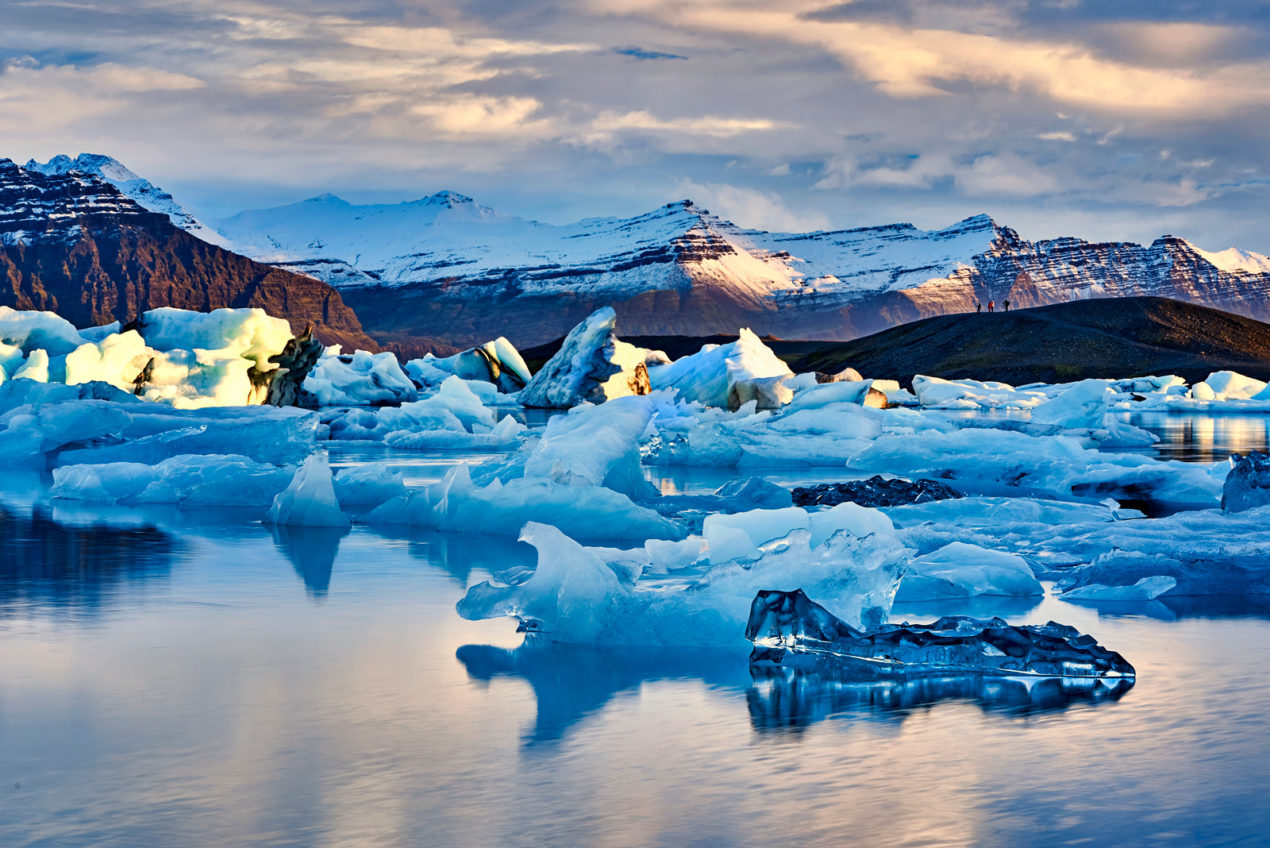Visiting Iceland: My Top Tips for an Awesome Trip
This page may contain affiliate links to products or services I’m happy to recommend. If you click on an affiliate link and then make a purchase, Artsy Traveler may earn a small commission at no cost to you. Thank you!
Most people travel to Iceland to experience some of the world’s most amazing scenery. And yes, the scenery is spectacular and definitely worth seeing.
But what I loved most about my recent travels in Iceland was discovering this island nation’s rich and fascinating history and culture.
Slow down and travel for at least a week to ten days in Iceland, preferably driving the Ring Road to experience as many areas of this remarkable country as possible.
Recent Posts about Iceland
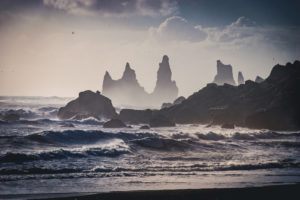
Best of Iceland on An 8-Day Ring Road Tour
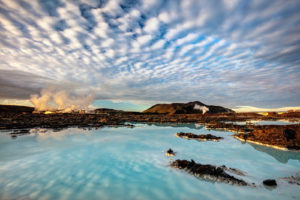
Should You Visit the Blue Lagoon in Iceland?
Introducing Iceland
When I first decided to visit Iceland, I felt overwhelmed by the sheer volume of amazing things to see. For such a relatively small country, Iceland punches way above its weight in terms of attractions.
No wonder over two million people a year visit Iceland, a country with a population of only 340,000, most of whom live in Reykjavik.
When to Visit
The large number of tourists who descend upon Iceland, particularly in the summer months, produces massive crowds at the major sites within day-tripping distance of Reykjavík. For that reason, I suggest you avoid the summer months and visit in late winter, early spring or early autumn.
The darkest months from November to January will be the least crowded, but you’ll also experience the least amount of daylight which cuts down your sightseeing options.
My daughter Julia and I visited Iceland in February and found clear and bright weather, freezing temperatures, sparse crowds, and the northern lights. So far as I can tell, Iceland can be cold at any time of the year, so to me, it makes sense to dress warmly and go when the crowds are at their lightest.
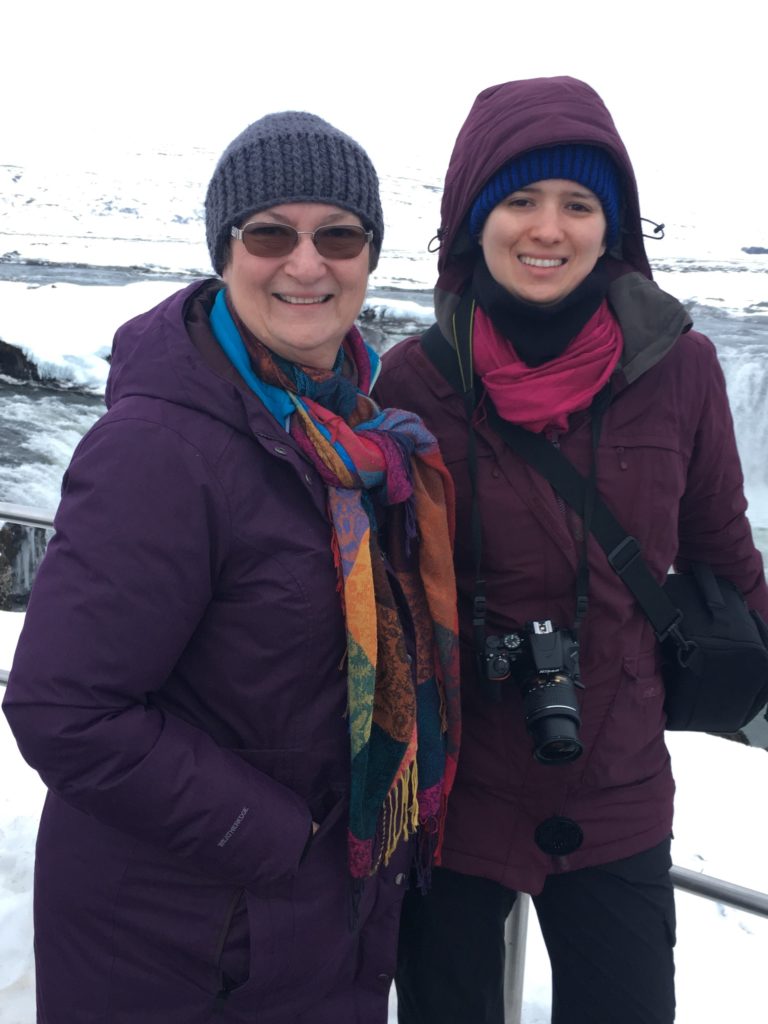
In winter, poor weather may cause road closures and other delays. On our trip in February, we encountered only one closure that lasted for about an hour so it wasn’t much of an inconvenience. I believe we were lucky!
More serious delays are likely. But you may consider the risk worth taking in exchange for finding many of Iceland’s most iconic sites virtually deserted and even busy Reykjavík manageable.
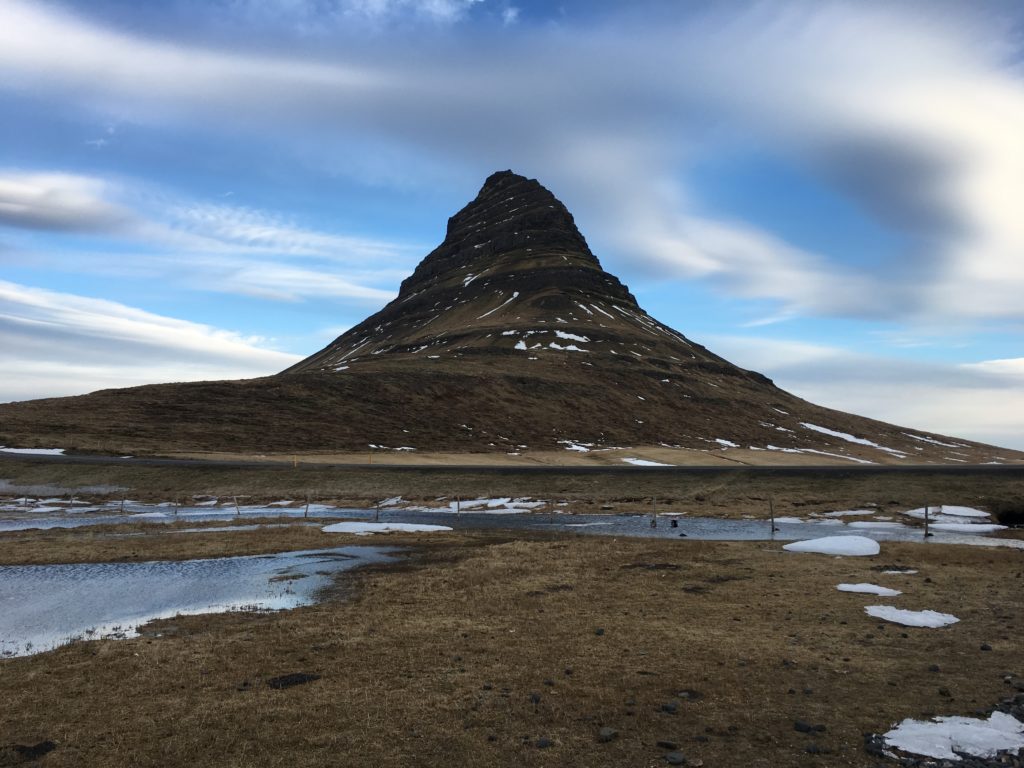
Iceland and the Sagas
You will not be in Iceland for long before you hear about the Icelandic Sagas. These stories date from the arrival of the Vikings in Iceland in 871±2 AD and permeate the Icelandic consciousness. As a novelist myself, I was fascinated by the characters depicted in the sagas.
Learn about Norseman Ingólfur Arnarson and his wife Hallveig Fróðadóttir, the first couple to settle in Iceland and live there for the rest of their lives.

Or what about Freydís Eriksdóttir who scared off an army by opening her tunic and laying her sword against her bare breast? Now there’s a gal I’d like to get to know!
The sagas are considered Iceland’s greatest contribution to world culture. Although written in the 12th century, most Icelanders can still read them in their original Icelandic because the language has not changed significantly in over 800 years. Impressive!
If you’re interested in the sagas, don’t miss the fascinating Saga Museum in Reykjavík. I write more about the museum in the Artsy Sightseeing section on this page.
Icelandic Place Names
When you’re planning a trip to Iceland, you are in danger of becoming overwhelmed by the long names attached to many of the attractions. Place names such as Skeiðarársandur, Breiðamerkurjökull and Dimmuborgir do not easily roll off English tongues.
How do you know what to see?
You can identify the meaning of some of the names by deconstructing them. Let’s look at a few of the most common ones.
Any name that ends in “foss” is a waterfall. So, if your itinerary includes Kirkjufellsfoss, Godafoss, Seljalandsfoss, and Gullfoss (among many others), know that you’re going to see a waterfall. And waterfalls in Iceland are mind-blowing.

A name ending in ” jökull” is a glacier. On your Ring Road tour, you’re likely to see Vatnajökull, Mýrdalsjökull and Eyjafjallajökull glaciers, to name just a few. One activity you must include during your Iceland itinerary is a glacier walk.
A name that ends in “fell” is a mountain or hill, the most famous being the iconic Kirkjufell mountain that was featured in Game of Thrones.
While daunting at first, you soon get accustomed to the long names even if you’re unlikely to be able to pronounce them correctly.
Planning to Travel in Iceland
Iceland is a small island floating in the north Atlantic and Arctic Oceans. If you set sail from the southern shore of Iceland, you won’t bump into another land mass until you get to Antarctica. That’s a lotta ocean, which probably accounts for the wild weather on Iceland’s south coast.
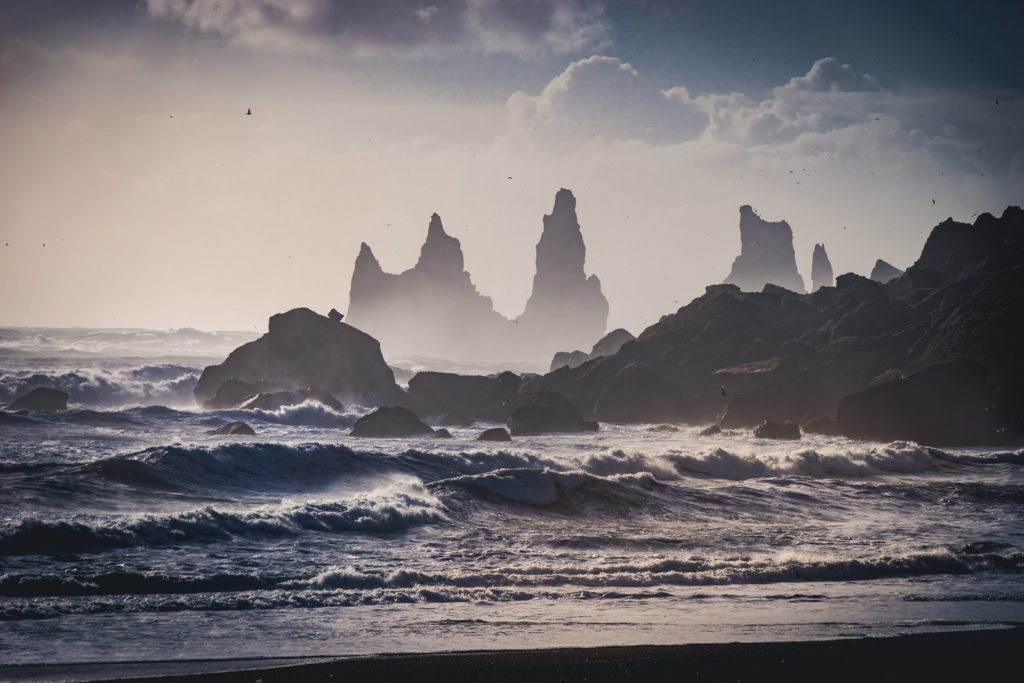
The best way to see Iceland is to follow its Ring Road, starting and ending in Reykjavík and taking in the famed Golden Circle of awe-inspiring sites northeast of Reykjavík.
If you go in the summer, consider renting a car or a camper van and driving the Ring Road yourself. This method is probably the most economical if you are traveling with two or more people.
Consider a Guided Tour
If you’re not traveling in the summer, consider leaving the driving to a professional. When I traveled to Iceland in February with my daughter Julia, we opted for a guided tour called The circle of Iceland in Winter 8-Day Guided Adventure that we purchased through Guide to Iceland.
The 16-seat mini-bus took us everywhere we wanted to go. Our incredibly competent and entertaining guide made the trip memorable–and safe!
Read my detailed account of our 8-day trip in Iceland in February: An Eight-Day Ring Road Adventure.
Get Equipped
No matter what time of year you plan to travel to Iceland, make sure you take a waterproof jacket, plenty of layers, rain or snow pants, hats, and gloves.
If you’re traveling in the winter, take “spikes” for walking on ice. Believe me, these handy steel-studded rubber slip-ons that you pull over your boots are literal lifesavers. On our second day in Iceland, we watched a young woman taken away in an ambulance after falling on the ice and badly injuring herself. We saw the same thing (different person) on the third day–and on the fourth.
Many of the parking lots are like skating rinks, as are the walkways leading to the waterfalls and scenic outlooks. Before you leave your car or the bus, slip on the spikes.
I purchased my spikes before I left Canada, but you can also buy them in Iceland at gas stations. In fact, our first stop on our Ring Road tour was a gas station where the guide told us to buy spikes if we didn’t already have them.
Choose Your Transportation
The two-lane Ring Road is paved and from my vantage point in the mini-bus appeared well-maintained. You’ll encounter some steep sections, particularly in the east, and a lot of traffic in the summer.
At any time of year, you can run into snow storms that make driving treacherous. Keep an eye on the weather and stay safe.
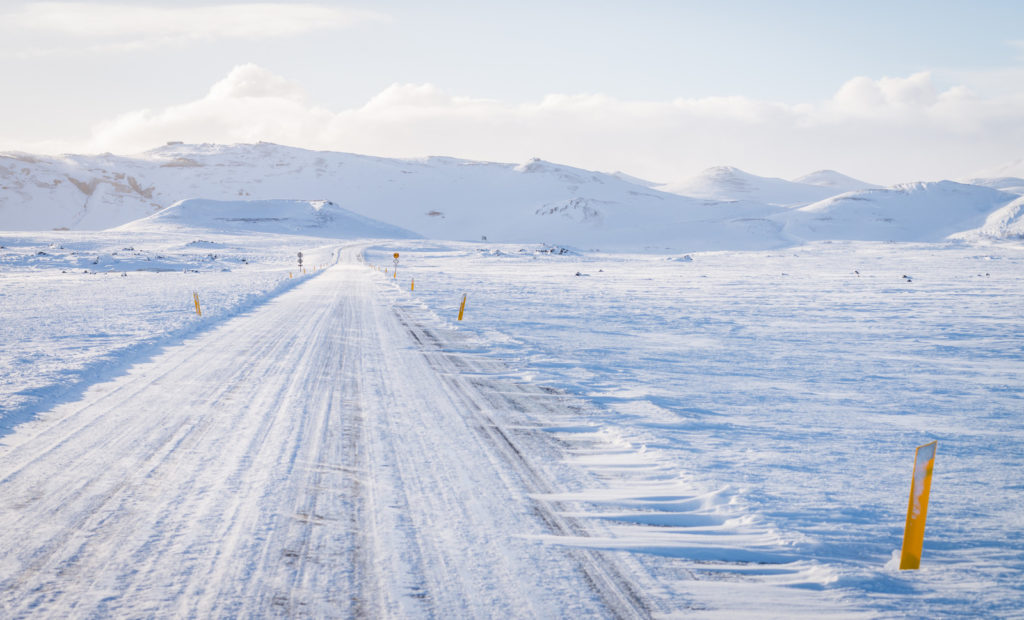
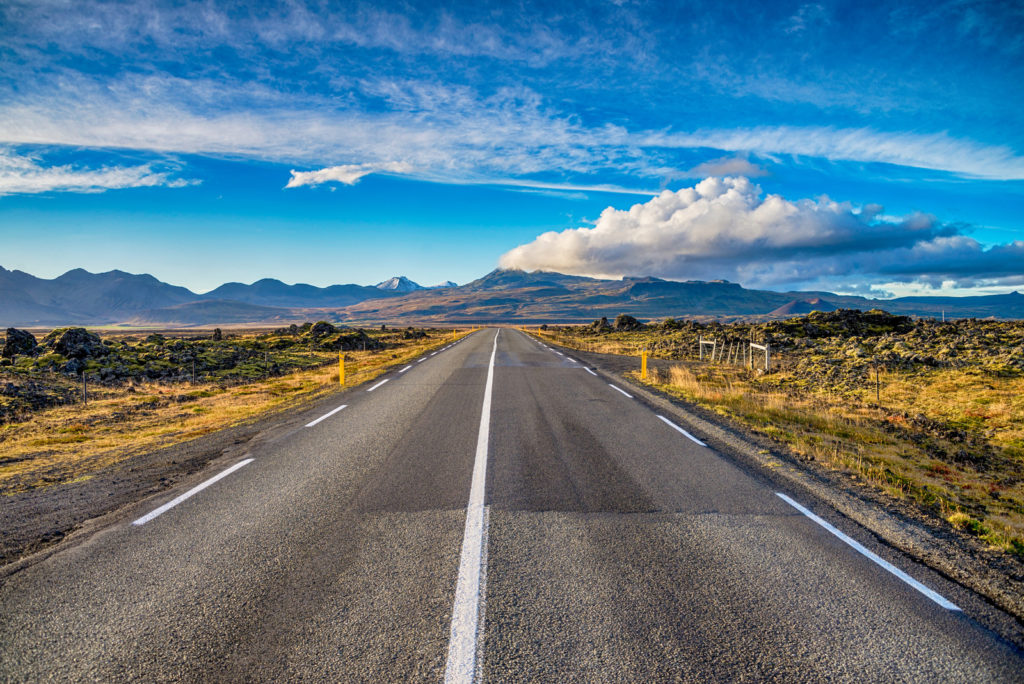
And watch out for the wind! Iceland is an extraordinarily windy place. When we were doing our glacier walk in the south, our guide told us about a woman who just that morning had the door of her rental car ripped off by the wind.
In Iceland, you must pay sober attention to the weather or risk injury, even death. Tourists have perished in Iceland—swept away by waves on Reynisfjara Beach, caught in poor weather while hiking, or involved in deadly car accidents.
Public Transit
You could travel around Iceland using local busses, but you’d need to carefully plan ahead. Find out which busses go where on the Public Transport website.
Rental Car or Camper Van
You can rent a car through a site such as Guide to Iceland because they can also book your hotels. Accommodation in Iceland is sparse once you get outside of Reykjavík. Hotels are being built to meet the demand of increasingly more tourism. However, you really need to plan ahead and book your accommodation before you go–sometimes months in advance to be safe.
You could also choose to rent a camper van. Check out 4 x 4 Camper Rental in Iceland and Budget-friendly Camper Rental in Iceland with Cozy Campers. I think in the summer months, having a camper van would be an awesome way to travel around Iceland and save a bit of money on accommodation.
Driving Tips
As mentioned, severe weather may close roads or make driving treacherous. Keep an eye on travel advisories. This website is a good resource.
Choose Activities
A highlight of your trip to Iceland is the opportunity to take part in a variety of unique activities. Snorkel between continents, walk on a glacier, ride an Icelandic horse, explore an ice cave, hike behind a waterfall, spot reindeer, climb into the depths of a lava cave, and watch out for whales.
Don’t stint on these activities. We took advantage of every activity offered on our tour except for whale watching and were very glad we did. I describe the tours we took in more detail in Iceland in February: An Eight-Day Ring Road Adventure.
Here are more options to consider.
Check for Events and Exhibitions
Before you travel in Iceland, check online for exhibitions and performances. Also be on the lookout for local festivals.
In Reykjavík, check what’s on at the awesome Harpa Concert Hall. This modern structure dominates the waterfront and is worth popping into even if you’re not attending a performance.
TIP: Avoid the Iceland in a Box movie shown on the lower floor at Harpa. It’s an expensive rip-off for a mediocre, 15-minute film. Unfortunately, we didn’t heed the advice in the reviews! Even the attendant who sold us the ticket look kind of surprised that we were bothering. Only one other couple was there, and they looked as unimpressed as we were.
In June, the Reykjavik Arts Festival, a biennial multidisciplinary festival features exhibitions and performances of contemporary and classical works in major cultural venues and unconventional spaces throughout the city.
Also check the What’s On website to find out about local festivals and other events in Reykjavík and elsewhere in Iceland.
Choose Where to Go in Iceland
Basically, you have two choices on a trip to Iceland. You either go for a few days and stay in Reykjavik while taking day trips out to the Golden Circle and to the glaciers and volcanoes on the south coast, or you go for at least ten days and combine a stay in Reykjavik with driving the Ring Road.
My advice? Spend two nights in Reykjavik and definitely (definitely!) drive the Ring Road or take the eight-day tour around the Ring Road.
We spent our first night in Reykjavik, went on our eight-day Ring Road tour around Iceland, and then stayed two more nights in Reykjavik before flying home. I’d have preferred spending more days on the Ring Road, and when I return to drive myself, I’ll allocate at least ten days to circle the country.
If you’re visiting in the summer months, you can add in a trip into the interior of Iceland, the vast wilderness that is closed during the winter. The scenery is beyond spectacular and generally crowd-free.
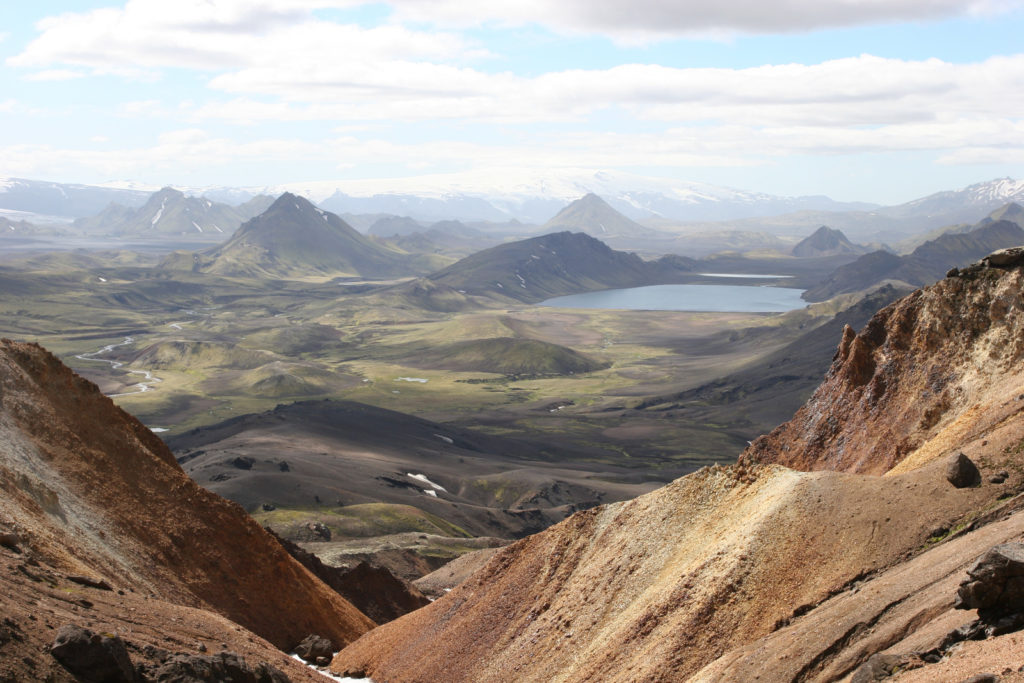
Map of Iceland
The map below gives a broad overview of the major areas of Iceland. You’ll start and end your Ring Road journey in Reykjavik.
Our tour took us around Iceland in a counter-clockwise direction, starting with the Golden Circle sites and ending with the Snæfellsnes Peninsula before heading back to Reykjavik.
We visited the Blue Lagoon just after landing in Keflavík International Airport on our first morning. Read about that experience in Iceland’s Blue Lagoon: Should You Go?
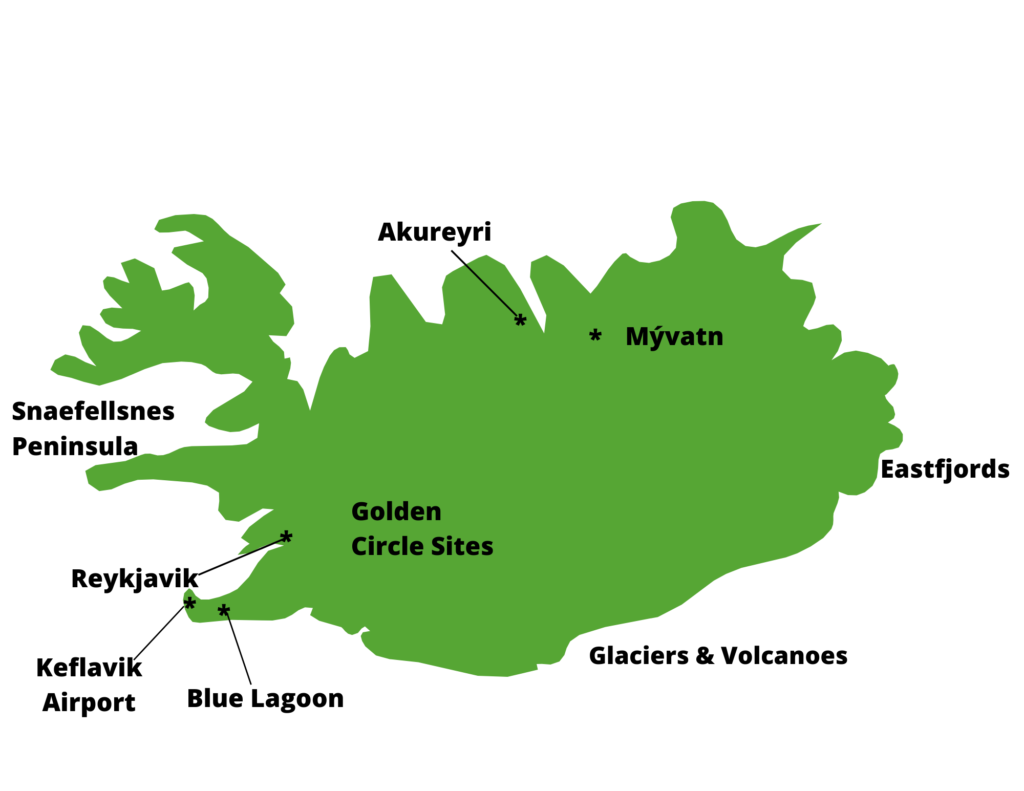
The Ring Road
You can “do” the 1,332 km (828 mile) Ring Road in as few as five days, but why? Even eight days felt too rushed. I would have loved to spend longer in so many of the areas, in particular the south coast, the eastern fjords, the north, and the Snæfellsnes Peninsula in the west.
When choosing a guided tour, spring for the longest one that fits your budget. Some tours offer to take you around in six days, but you’ll miss some of the “must-sees” and spend too much time on the bus.
Although eight days wasn’t long enough, we did at least see most of the highlights and had time to participate in several activities, such as horseback riding, hiking on the glacier, and exploring an ice cave like we did in the pictures below.
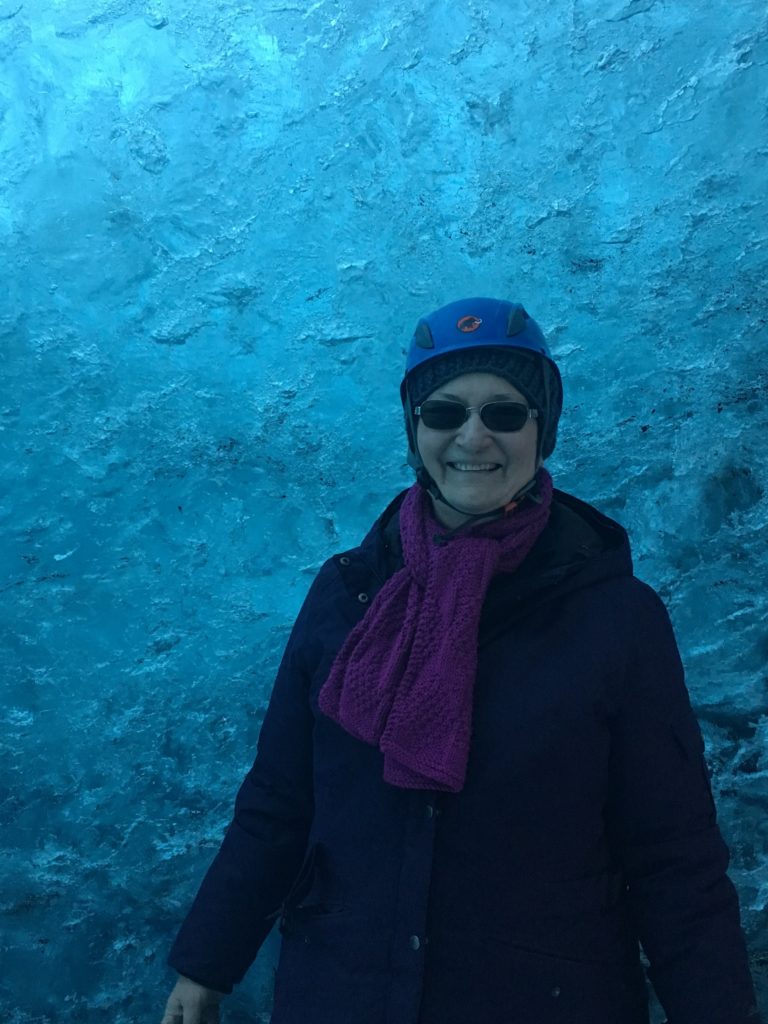
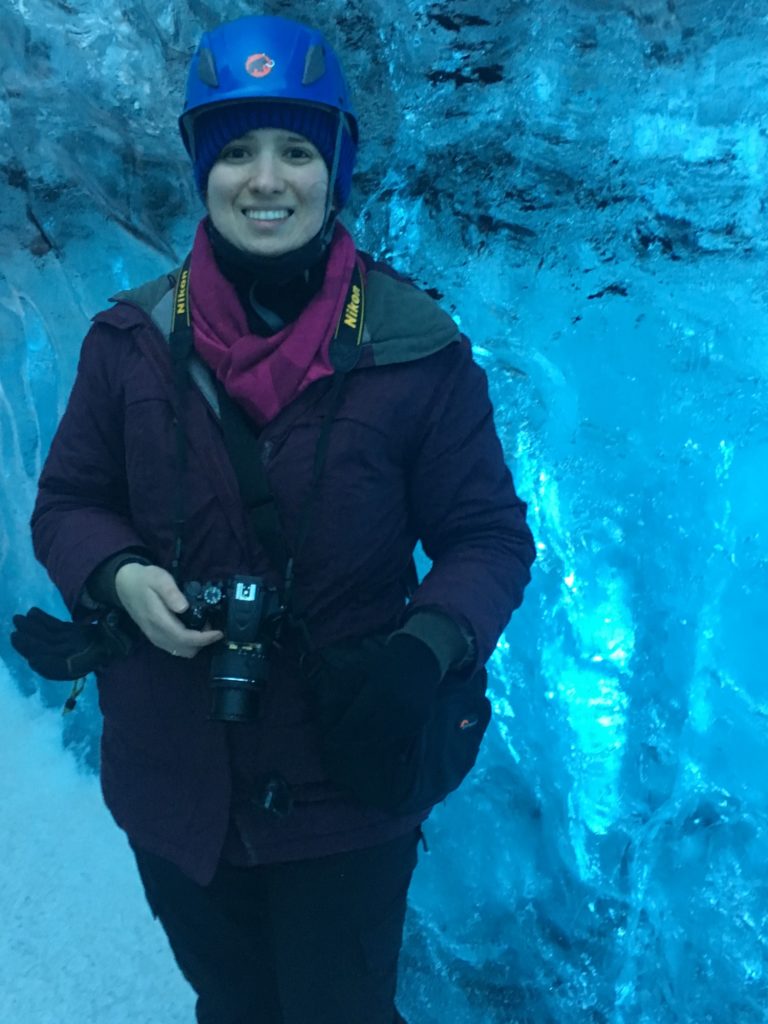
For a detailed description of our eight days on the Ring Road, see Iceland in February: An Eight-Day Ring Road Adventure.
Following are four popular areas to enjoy in Iceland: Reykjavik, the Blue Lagoon, the Golden Circle, and the Ring Road. Included are links to additional posts which provide more detailed information.
Reykjavik
Although the largest city in Iceland where the vast majority of the population lives, Reykjavik is wonderfully walkable with plenty of excellent museums, shopping, and restaurants.
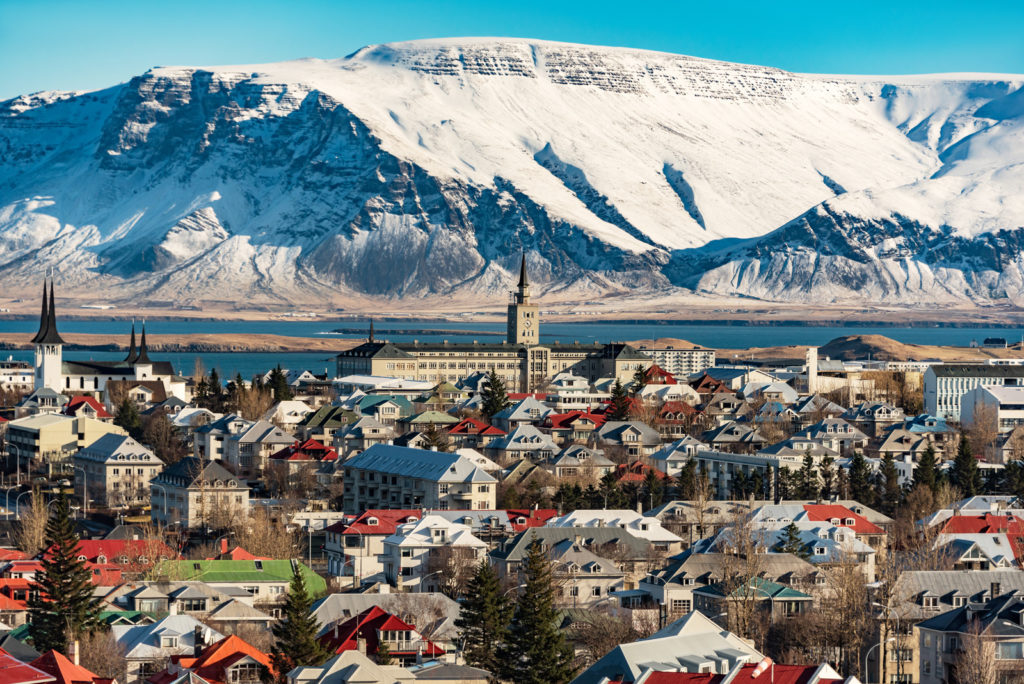
We spent the afternoon of our first day in Iceland exploring Reykjavik and then a full day and two nights after returning from our Ring Road tour.
I could have stayed longer!
Here’s a list of my favorite sites in Reykjavik that we enjoyed during our visit in chilly February.
Favorite Sites in Reykjavik
Laugavegur Stroll
Laugavegur is the main drag that takes you from Hallgrimskirkja Church at the top all the way down to the harbor. Explore the many shops along Laugavegur and adjacent streets. Yes, many of the shops are full of tourist dreck, but wander in anyway. You just might have to buy a stuffed puffin or two.
A highlight for me was the Handknitting Association of Iceland at Skólavörðustígur 19 to buy Icelandic sweaters and yarn.
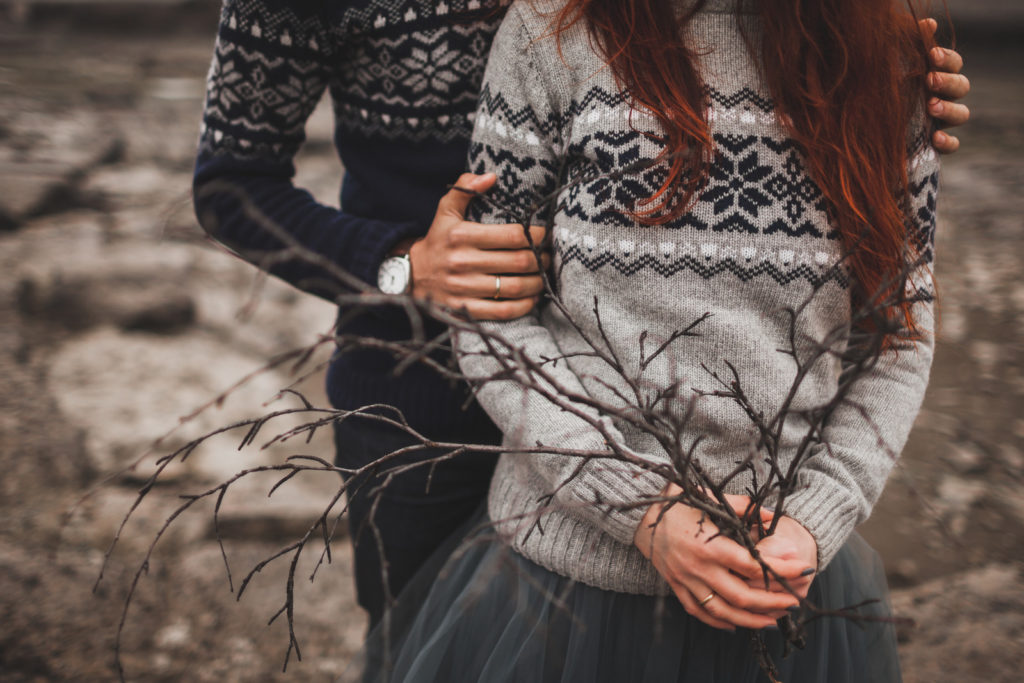
Another great stop is the Mál og Menning bookstore at Laugavegur 18 to buy books about Iceland and other quality souvenirs. Iceland is one of the most literate nations on Earth.
At Mál og Menning, you’ll find lots of books in translation by local and international authors (including a few of mine!).
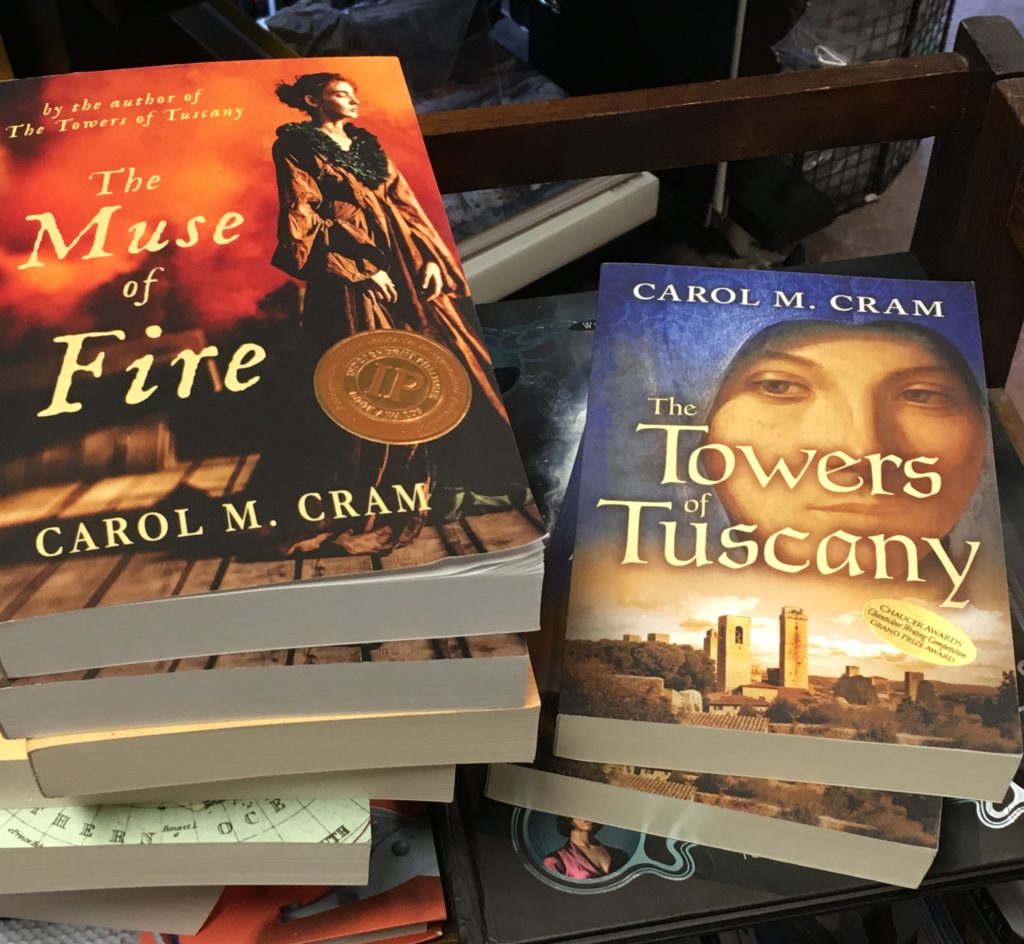
Souvenirs in Reykjavik
Souvenir stores abound in Rekyjavik, some better than others. You’ll find a LOT of schlock–from stuffed puffins to tacky mugs, key chains, and tea towels. You’ll also find some lovely souvenir stores that stock more authentic souvenirs including Icelandic salts (recommended), sweaters, cold weather gear (pick up a pair of gloves made with Icelandic wool), handcrafted jewelry, and gorgeous coffee table books about Iceland.
Here’s a particularly large puffin spotted in a souvenir store on Laugavegur. You might need to buy a separate plane seat to take him home.
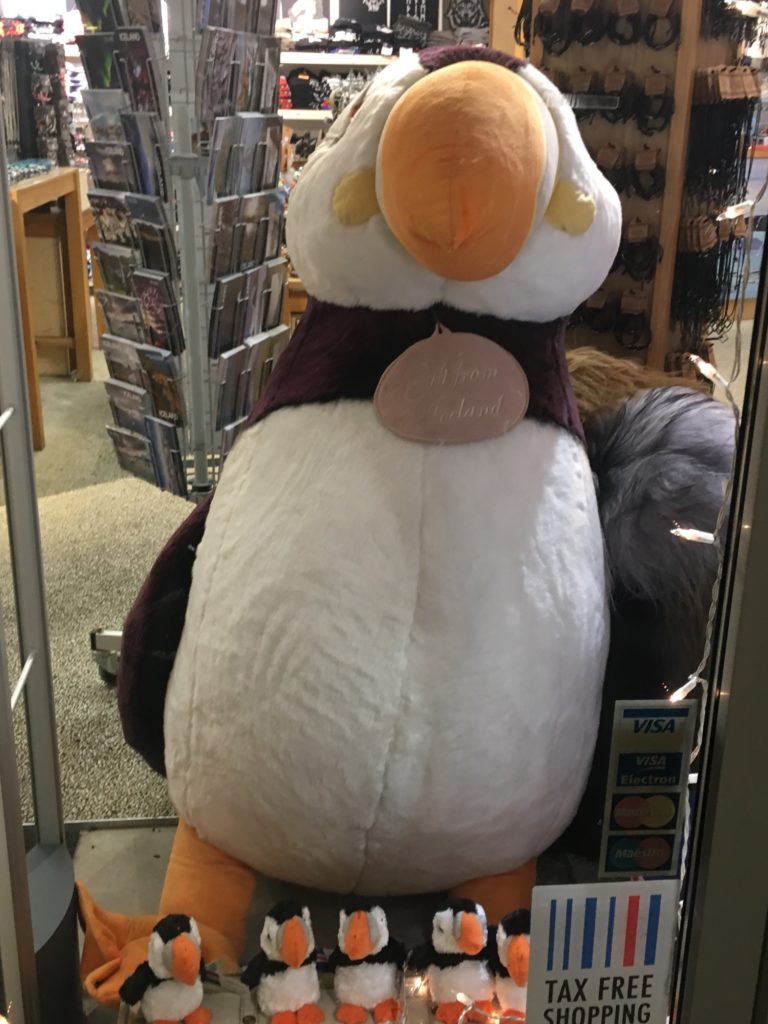
You’ll find souvenir stores all over Iceland. I think the prices are pretty consistent.
Hallgrimskirkja
The massive spire of the largest church in Iceland (“kirkja” means “church”) dominates the top end of Laugavegur Street. Go inside to enjoy the soaring architecture and the profound feeling of peace (and warmth) on a cold day. Admission is free.
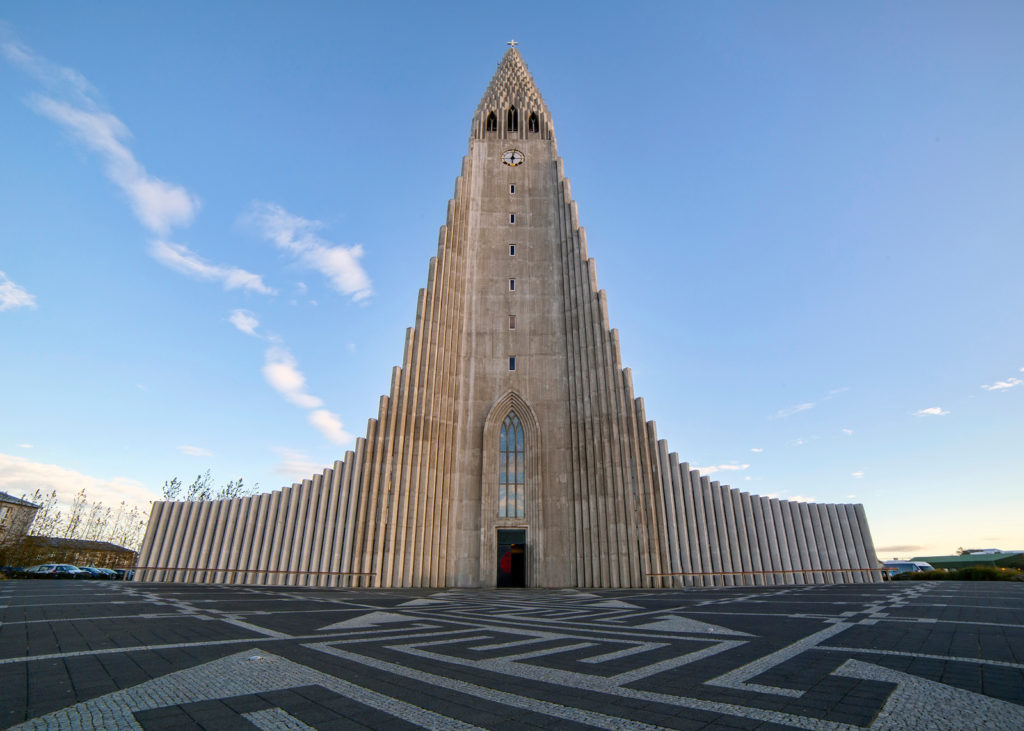
Saga Museum
I suppose it’s a bit cheesy and will definitely be a hit with children, but I loved the Saga Museum. Walk through a series of tableaux depicting gorgeously detailed wax figures from the sagas. We were the first people to arrive in the morning and had the place to ourselves.
For more about the museum, see Artsy Sightseeing below.
Landnámssýningin/The Settlement Exhibition
This wonderful museum tells the story of how Rekyjavik was settled back in 871±2 (the exact year is estimated). View the archaeological excavation of one of the first houses in Iceland.
The Settlement Exhibition at Aðalstræti 16 is open daily from 9 am to 6 pm. Check the website for more information.
Aurora Reykjavik
We visited this excellent museum on our first evening in Reykjavik prior to setting out on our own quest for the northern lights. One of the reasons we chose to visit Iceland in February was because we wanted to see the northern lights.
And fortunately we did. See the post Iceland in February: An Eight-Day Ring Road Adventure.
Aurora Reykjavik at Grandagardur 2 near the old harbor is open from 9 am to 9 pm. The museum provides an exciting and educational overview of the aurora phenomenon and includes an awe-inspiring film. Not to be missed!
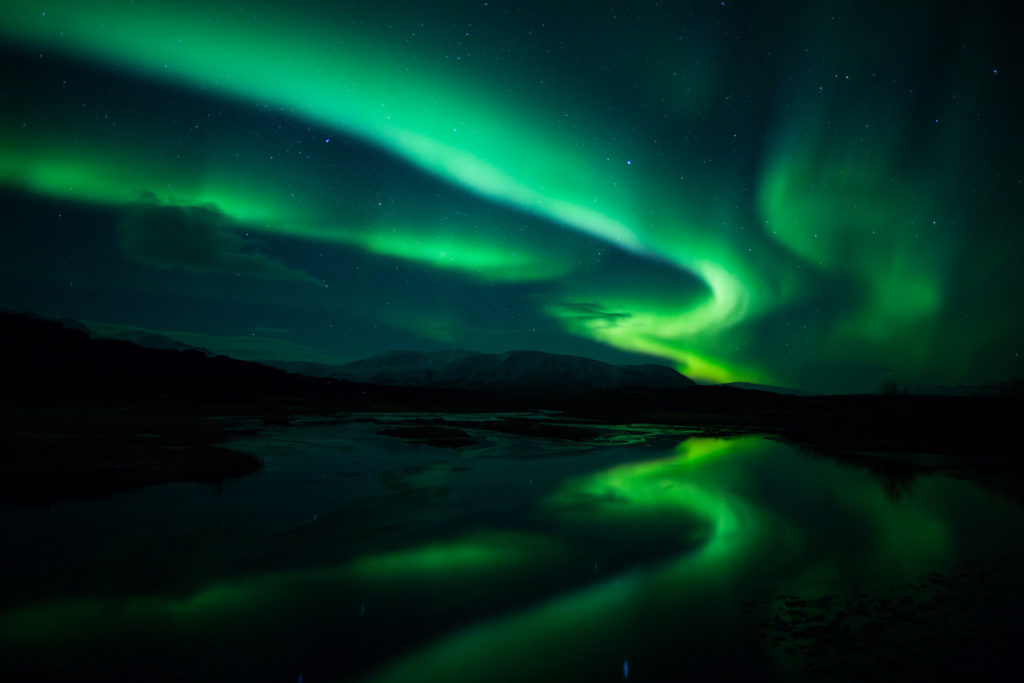
Murals
As you wander around Reykjavik, you’ll see murals painted on the sides of buildings. These quirky murals will make you smile!
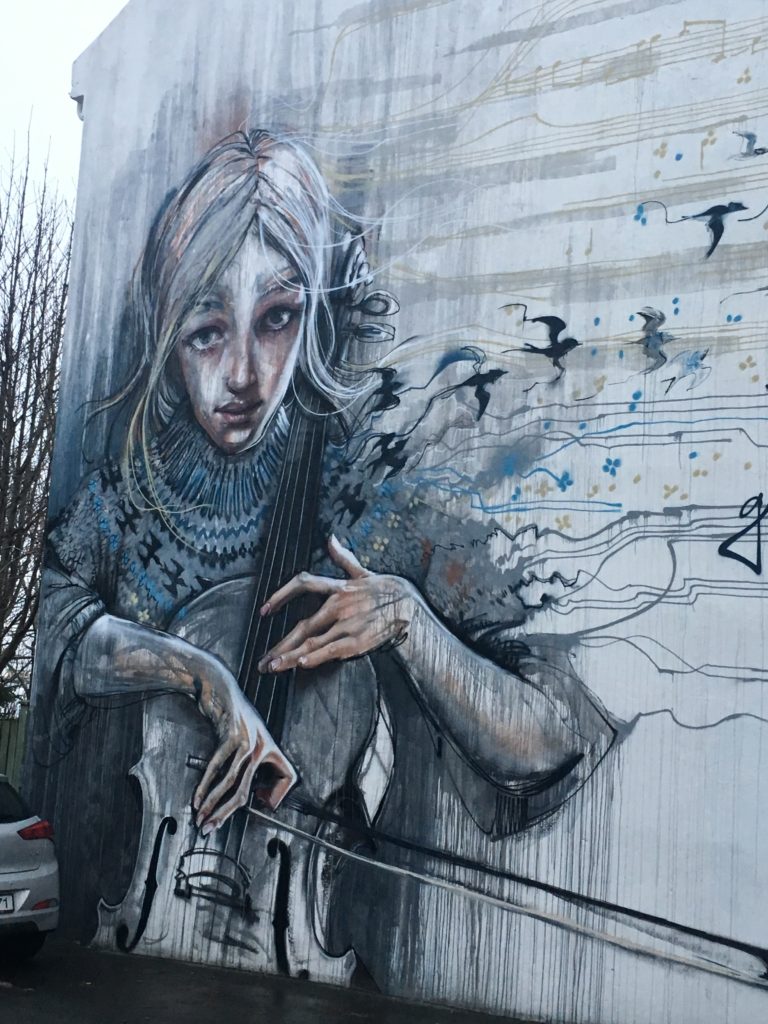
Sun Voyager Sculpture
This iconic sculpture by hometown boy Jón Gunnar Árnason overlooks the harbor. Stop for a photo op.
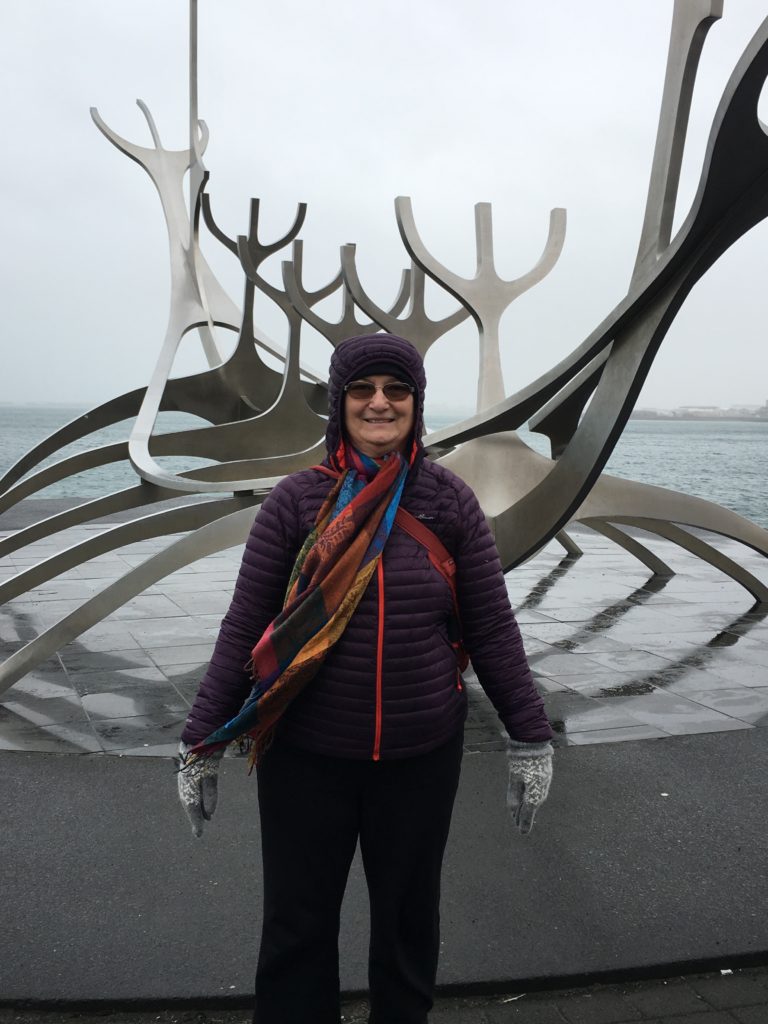
Art Galleries & Museums
With just a day and a half in Reykjavik, we regrettably did not have time to visit the National Gallery of Iceland and the National Museum of Iceland. However, both are well worth visits.
Laugardalslaug Swimming Complex
For a fraction of the price of the Blue Lagoon, consider enjoying the Laugardalslaug public thermal baths and swimming pool complex (the largest in Iceland) at Sundlaugarvegur along with the locals. Check the website for location and opening times.
Fly Over Iceland
The Fly Over Iceland attraction was not yet operating when we visited Iceland. I’ll definitely visit it on my next trip.
Tickets for Reykjavik Tours and Museums
Save time by buying tickets for Reykjavik sights before leaving home.
Blue Lagoon
A dip in the Blue Lagoon will cost you big bucks. Is the experience worth it? I say yes, but only if you visit either very early in the morning (like we did) or in the evening.
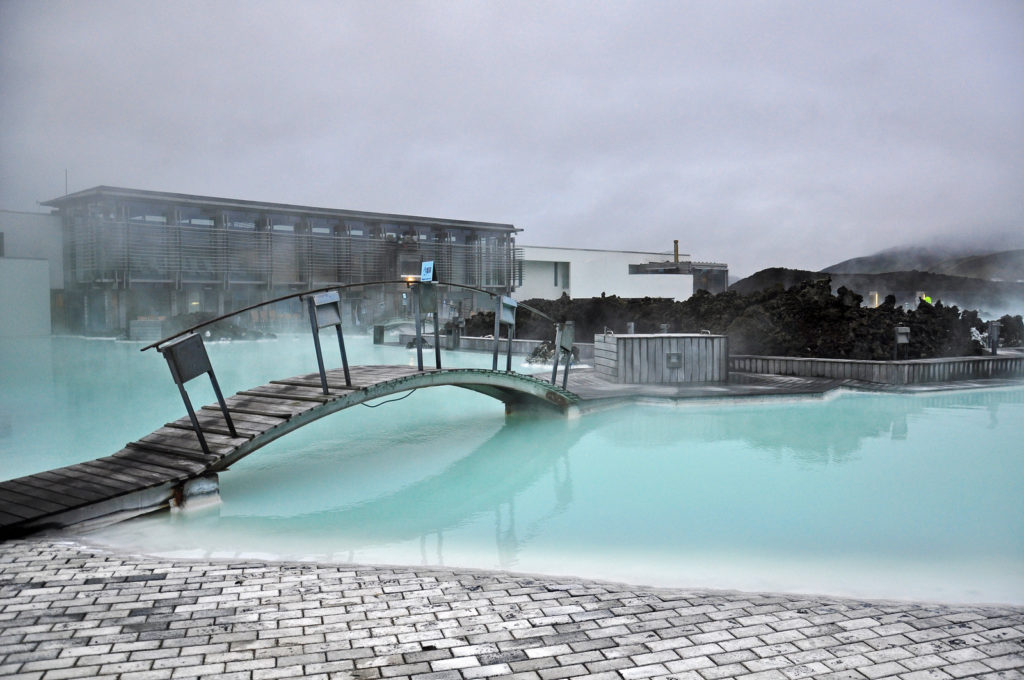
Although entrance to the Blue Lagoon is strictly regulated so the lagoon will never be bobbing room only, the crowds increase by midday and into the afternoon. Fortunately, the steam obscures a lot of your fellow lagoon-goers, but the changerooms do get busy.
For a detailed account of our morning at the Blue Lagoon, see Iceland’s Blue Lagoon: Should You Go?
Golden Circle
Thanks to an aggressive marketing campaign by Icelandic Air (a highly recommended airline, by the way), millions of people touch down at Keflavik International Airport for a two or three-day layover each year. Most of these visitors will spend one of those days touring Iceland’s famed Golden Circle.
It’s a shame to go to Iceland only for a few days and just see the Golden Circle. The country is worth at least a week or more. While amazing, the three main attractions in the Golden Circle are easily outmatched by other places that require a longer stay to explore. Why go all the way to Iceland and then miss the awesome glaciers on the south coast or the Mývatn Nature Baths in the north?
That said, what’s to see on the Golden Circle?
Getting to the Golden Circle
If you’re visiting in the winter or for a short time and don’t want to rent a car and drive the Golden Circle yourself, then take a tour to the Golden Circle. You’ll find plenty of options on the Guide to Iceland website and below.
The Golden Circle covers about 300 kilometers (190 miles), looping north from Reykjavik into the southern uplands of Iceland and then back to Reykjavik.
We visited the Golden Circle on the first day of our eight-day tour and then carried on from the third stop (the Gulfoss Waterfall) to the south coast where we road Icelandic horses. See Iceland in February: An Eight-Day Ring Road Adventure.
You visit three major sites on the Golden Circle.
Þingvellir National Park
Þingvellir National Park (pronounced “Thingvellir”) is a UNESCO site and the former site of theAlthing, the oldest parliament in the world. It’s about 40 km northeast of Reykjavik and will probably be the first site you visit on the Golden Circle tour.
The park lies in a rift valley that is the crest of the Mid-Atlantic Ridge where the North American and Eurasian tectonic plates meet. If you’re adventurous, you can actually snorkel between the plates in the Silfra canyon. How cool is that?
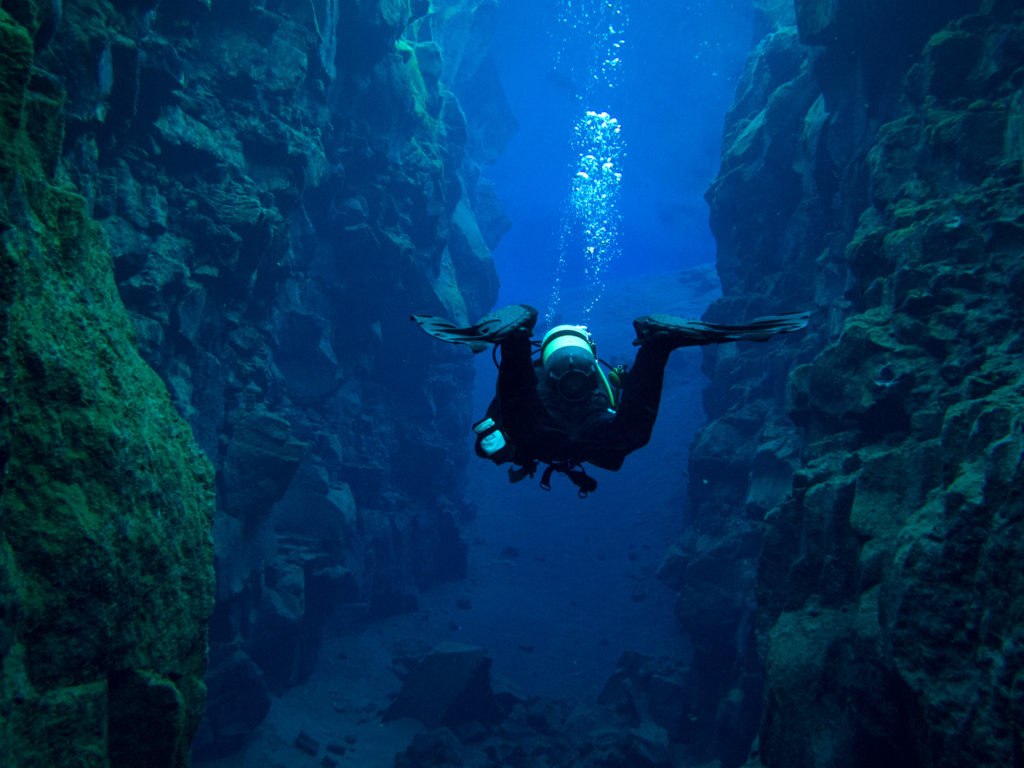
At Þingvellir, you’ll also learn about the Althing, the national parliament of Iceland that was established here in 930 AD. There is a lot to see in the park, and if you love history and geology, you’ll need more time than is allocated on a one-day Golden Circle tour.
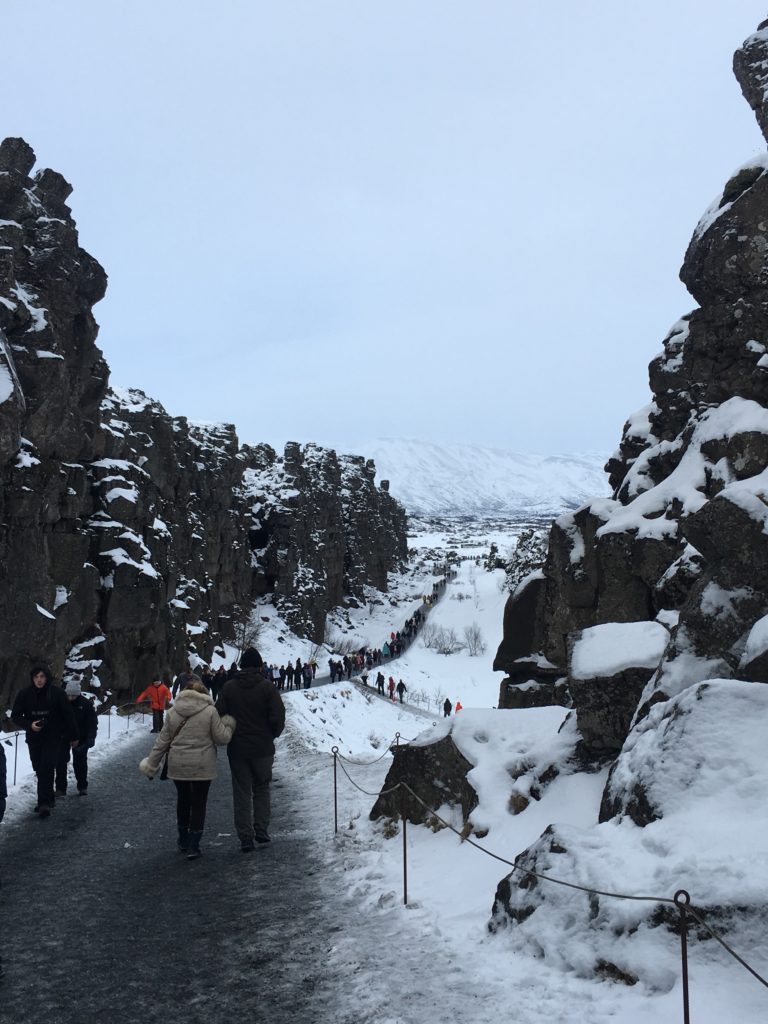
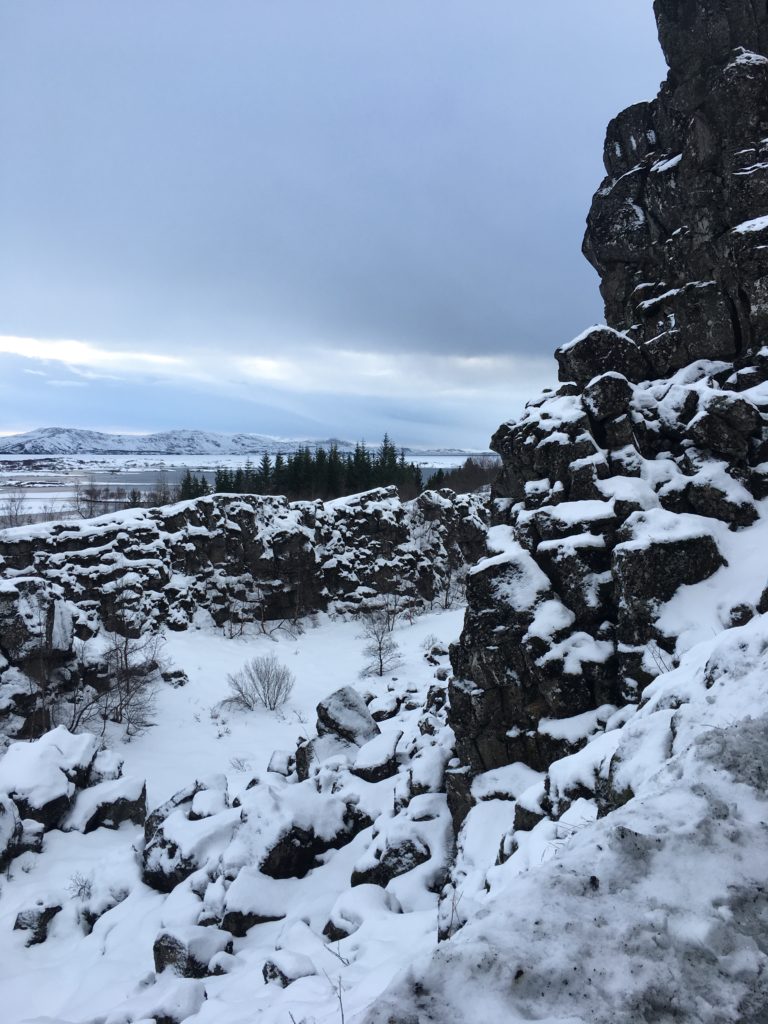
I look forward to returning in the summer months when the long days will provide plenty of daylight for more exploring. I’m particularly interested in learning more about the Althing.
Geysir Geothermal Area
Here’s where you’ll see the original Geysir that lent its name to all the other geysers around the world. You won’t see it erupt very often these days, but you will likely see the nearby Strokkur blast water as high as 30 meters every five minutes or so.
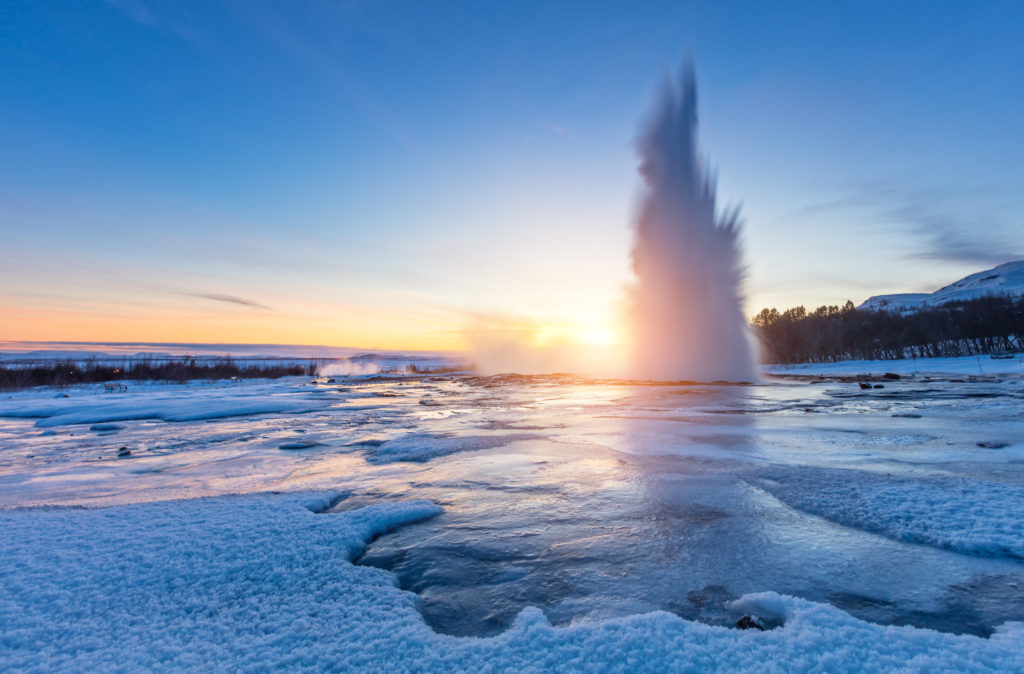
The walk through the colorful geothermal area is stunning. Near the parking area is a large cafeteria with pretty good food. I recommend ordering one of the delicious soups on the menu.
TIP: Soup is generally a wise choice for a reasonably-priced lunch in Iceland because it’s filling, nutritious, and tasty. Lamb soup is a specialty.
Gullfoss
Gullfoss (Golden Falls) is the very large and astonishingly beautiful waterfall that is the reason why the Golden Circle is called the Golden Circle.
As mentioned, you’ll learn quickly in this country awash with waterfalls that “foss” means waterfall. If you don’t want to look like a total tourist, avoid saying Gullfoss Waterfall, which is like saying “golden waterfall waterfall.”
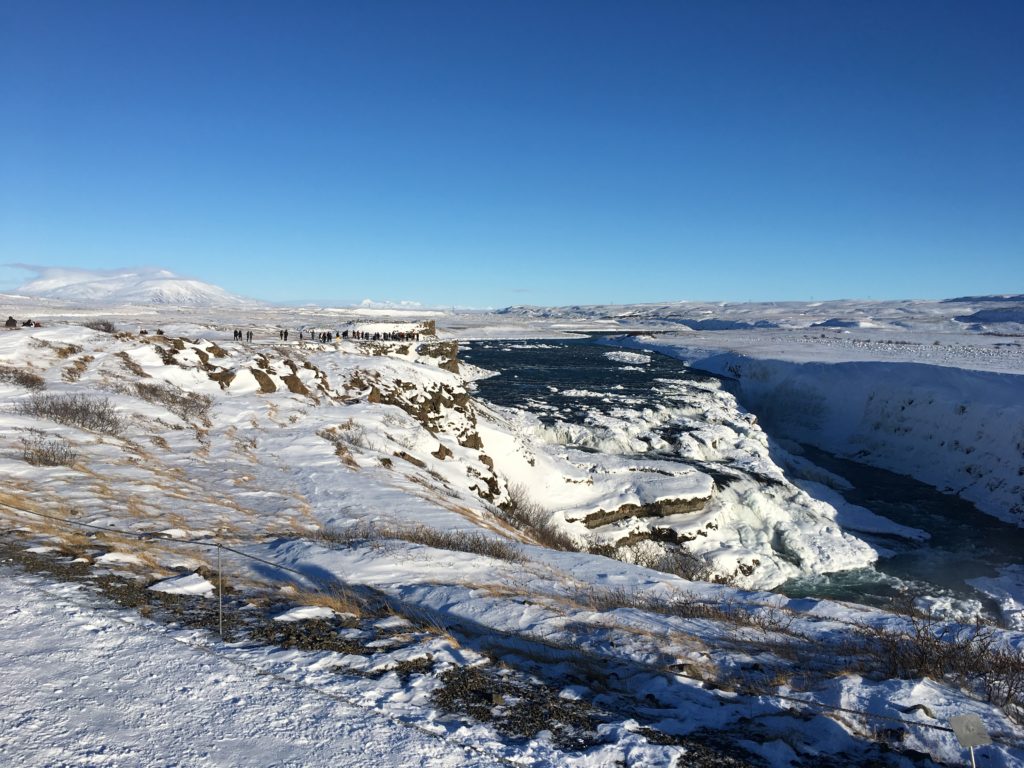
In February, a portion of the falls is frozen into wonderful, bulbous shapes that somewhat mute the roar of the water spilling from the wide river into two narrow canyons. Walk to the various viewing platforms to enjoy the waterfalls and canyons from a variety of angles.
Landscape On the Golden Circle
Our driver stopped frequently on our tour of the Golden Circle so we could enjoy the spectacular landscapes.
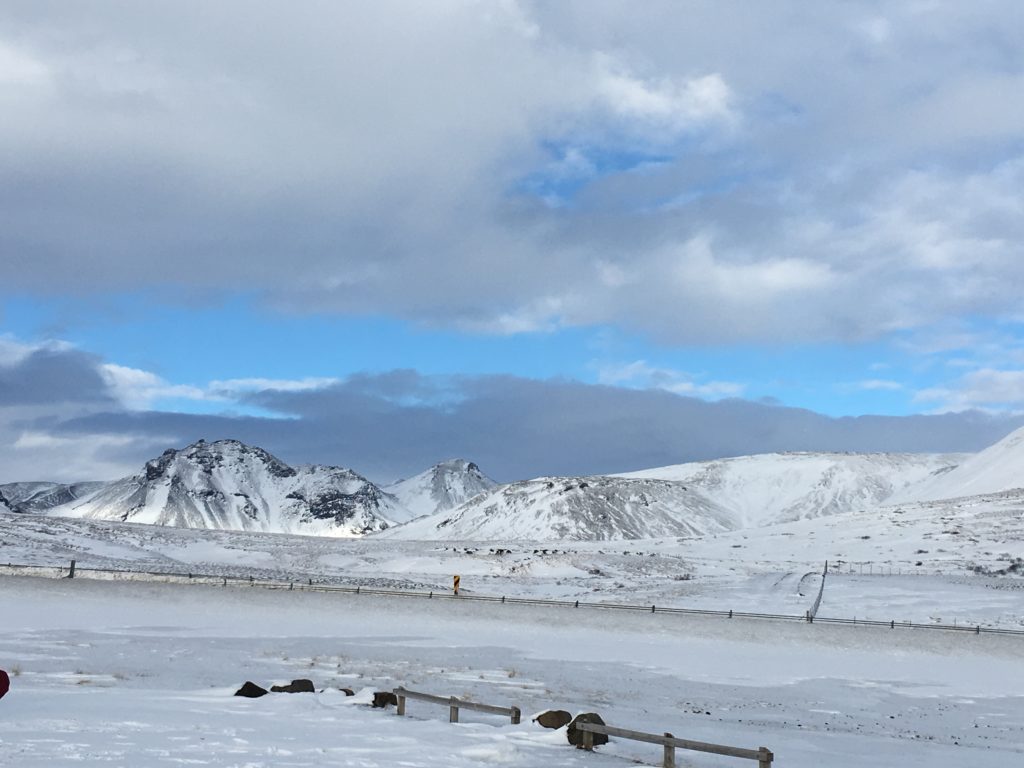
The Ring Road
I’ll list here only the highlights of our Ring Road tour in the order we encountered them to give you a sense of what to expect. For more details, see Iceland in February: An Eight-Day Ring Road Adventure.
After visiting the three major sites on the Ring Road (see above), head east to begin your circle tour of Iceland.
South Coast
- Waterfalls: Skógafoss and Seljalandsfoss
- Lava Center
- Eyjafjallajökull Glacier
- Hike on Sólheimajökull
- Vatnajökull National Park
- Reynisfjara black sand beach
- Town of Vik
- Skeiðarársandur black sand desert
- Skaftafell National Park
- Ice caving on Jökulsárlón
- Jökulsárlón glacier lagoon
Eastfjords
- More spectacular scenery and fjords
- Reindeer spotting
- Forest of Hallormsstaðaskógur
- Lake Lagarfljót
The North
- Lake Mývatn & the Mývatn Nature Baths
- Dimmuborgir rock formations
- Námaskarð geothermal area
- Goðafoss (Waterfall of the Gods)
- Eyjafjörður fjord
- Akureyri – Iceland’s second city
- The charming fishing settlement of Hauganes settlement with its black sand beach
West Iceland
- Snæfellsnes Peninsula
- Deildartunguhver hot springs
- Reykholt, home of Snorri Sturluson (see Artsy Sightseeing)
- Waterfalls Hraunfossar and Barnafoss
- Snæfellsjökull glacier
- Kirkjufell
- Vatnshellir lava cave
Artsy Favorites in Iceland
Following are a few artsy highlights we enjoyed in Iceland. Most relate to Iceland’s long literary traditions. You’ll also find a lively music scene and clubs in Reykjavik. Check the What’s On website for more information.
Saga Museum
Visit the Saga Museum to learn about the Icelandic sagas. Are they legends? Are they real? I don’t know, but the stories are fantastic.
Each of 16 sagas is depicted as a tableau of wax figures and explained in quite a bit of detail. Arrive early and you’ll likely have the place to yourself.
You could spend a lot of time here reading about each saga and admiring the incredible detail of the figures. At the end of the exhibit, a short film explains how the figures were made.
The sagas begin with the oldest Icelandic record written by Ari Þorgilsson, better known as Ari fróði or Ari ‘the Learned’, in the period 1122-33 AD.
He describes how the first Norsemen to arrive in Iceland (871±2) found “Christian men here, whom the Norsemen called papar, but they left because they did not want to share the land with heathens. They left behind them Irish books as well as crooks and bells from which it is possible to determine their origin.”
This is the only mention by Ari the Learned of the Christian inhabitants of Iceland.
I thoroughly enjoyed reading each of the long descriptions (all in English!) and snapping photos of the displays. After watching the film, Julia and I succumbed to the temptation to dress up as Vikings. When in Iceland…!

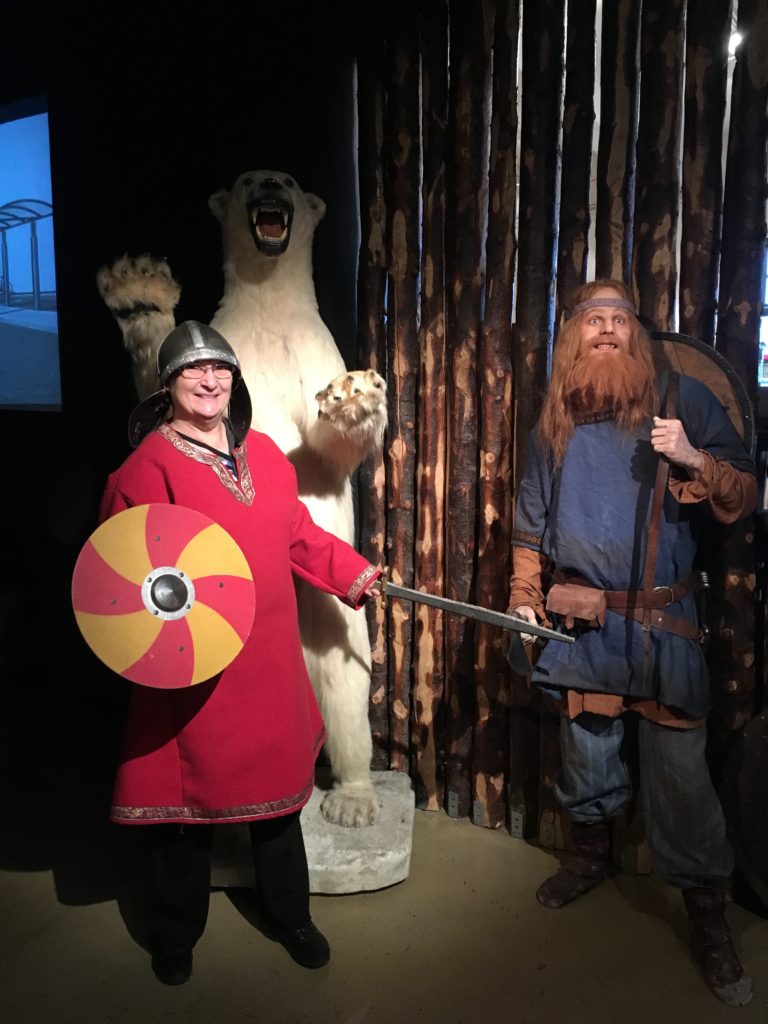
Statue of Gudrid Thorbjarnardóttir
Gudrid Thorbjarnardóttir was born in Snæfellsnes in 980 and during her lifetime took eight sea voyages and traveled twice across Europe as far as Rome.
She appears in the Saga of Erik the Red and the Saga of the Greenlanders (you’ll learn about both at the Saga Museum). Along with one of her husbands, Þorfinn Karlsefni, Gudrid traveled to Vinland, the area surrounding the Gulf of St. Lawrence in eastern Canada. Her son, Snorri Þorfinnsson, was born there and is believed to be the first European birth in the Americas.
We visited the evocative statue of Gudrid Thorbjarnardóttir while traveling toward the Snæfellsnes Peninsula.
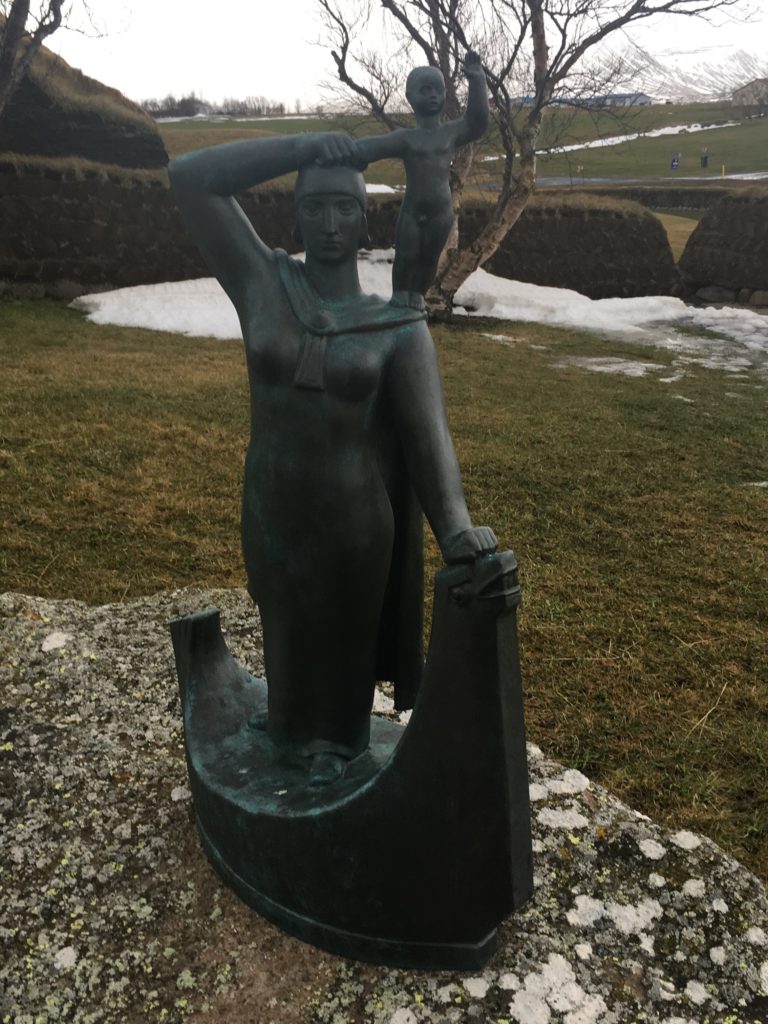
As an aside, in Iceland, a woman’s last name usually includes the first name of her father followed by “dóttir”. A man’s last name includes the first name of his father followed by “son”. So Gudrid was the daughter of Thorbajarnar. A man with the last name of Erikkson is the son of Erik.
Home of Snorri Sturluson
Snorri Sturluson is to Iceland what Shakespeare is to England. He was a saga writer, politician, historiographer, and poet who lived from 1179 to 1241. You’ll find Snorri’s home and cultural centre in Reykholt in west Iceland.
Reykholt was an ecclesiastical and cultural center back in medieval times. The charming church makes for a great photo op.
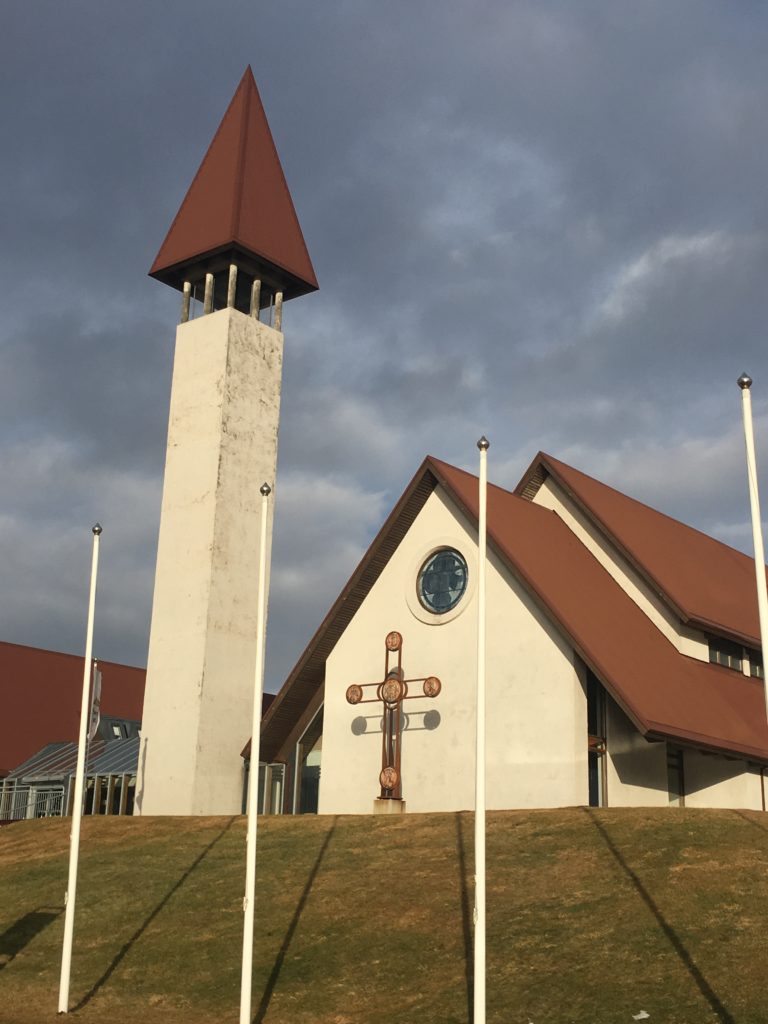
Practical Tips for Travel in Iceland
Communicating in Iceland
English is widely spoken in Iceland. You’re unlikely to encounter anyone, particularly in the service industries, who does not address you in English.
If you’re on a tour, ask your guide to explain Icelandic words to you. As mentioned, you’ll quickly learn the meaning of suffixes, such as foss (waterfall), jökull (glacier) and fell (mountain).
Learn how to say ‘thank you’—Takk fyrir— and earn some smiles.
Eating in Iceland
Two words–fish and lamb. If you like either or both, you’ll get well fed in Iceland. If you don’t, you might find yourself out of luck at dinner time in some of the posher hotel restaurants around the Ring Road. Fortunately, you’re usually able to find hamburgers, pizza, and fries at cafeterias attached to rest stops and gas stations, particularly at lunchtime.
I loved eating in Iceland! Every morning started with thick slices of warm bread slathered with the best butter I’ve ever tasted. The breakfast buffets at our hotels also included plenty of smoked salmon, eggs, and skyr.
What is skyr? If you’ve never tasted skyr, you’re in for a treat. Skyr is Icelandic yogurt. Thick, creamy, high in protein, and surprisingly low in calories, skyr puts regular yogurt to shame.
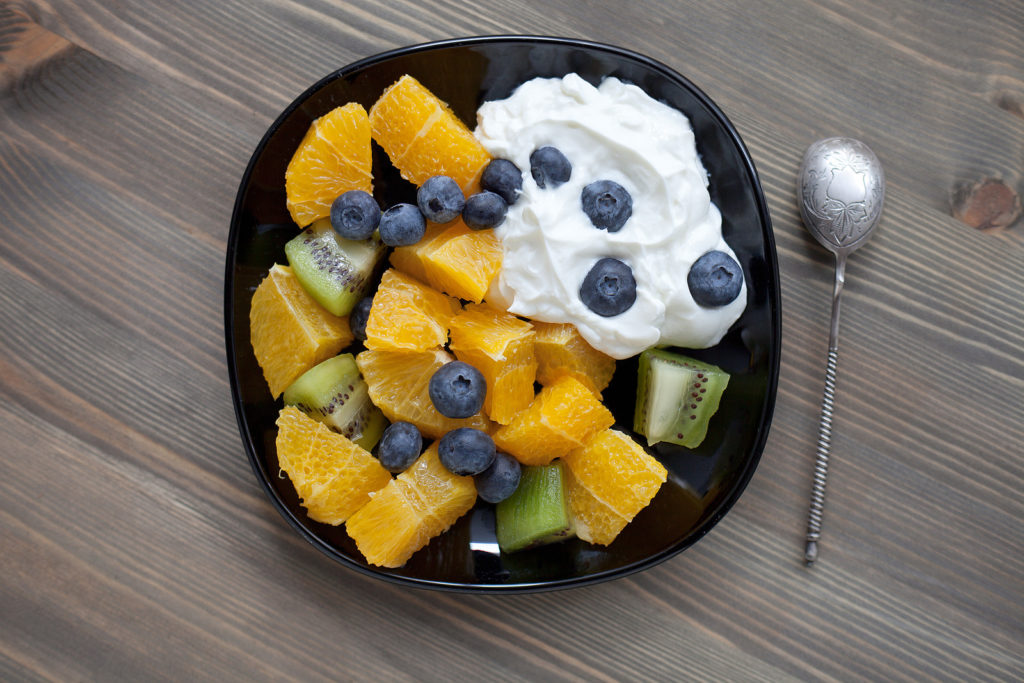
Lunch usually consisted of a thick lamb soup or a hamburger at a cafeteria attached to a rest stop or attraction. For dinner, I was happy to sample whatever fish or lamb dish was on the menu.
Food is very expensive in Iceland. In a hotel dining room, expect to pay about €50 per person for dinner. Even a simple sandwich can cost about €20. If you’re staying in places with kitchens, save money by shopping in grocery stores.
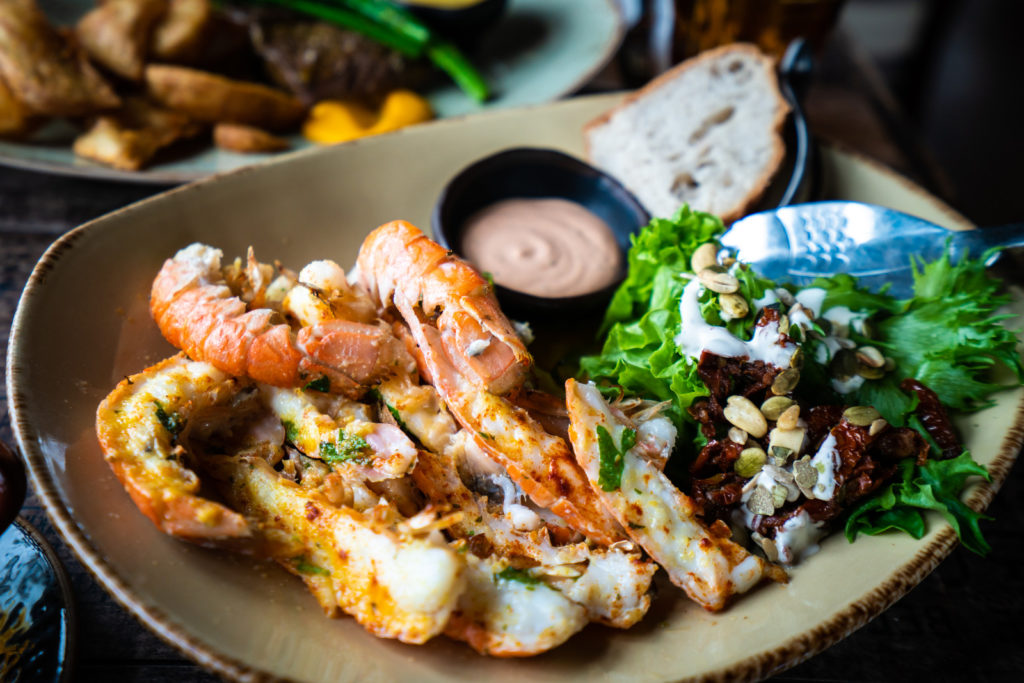
Staying in Iceland
On our tour around Iceland, we stayed in wonderful hotels, many newly built, that had been booked by the tour company. If you’re planning to drive the Ring Road yourself, you must make reservations well in advance. Hotel prices are high, but in my experience, the quality of the accommodations was first-rate.
For specific hotel recommendations, see Iceland in February: An Eight-Day Ring Road Adventure.
On our arrival in Iceland, we stayed in the Hotel Ódinsvé, a modest place centrally located near the Hallgrimskirkja Church at the top of Laugavegur Street in Reykjavik. We were able to walk everywhere we wanted to go.
When we returned to Reykjavik after the tour, we rented an apartment for two nights near the old harbor. It was spacious and beautifully appointed—and at about $200/night was very reasonably priced for Reykjavik. If you’re staying in the city for two or more nights, consider booking an apartment.

Have You Been to Iceland? Please share your tips and suggestions for travel in Iceland with other artsy travelers in the Comments section below.
